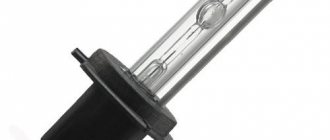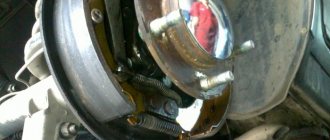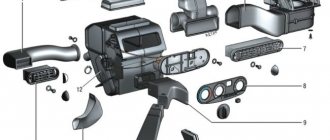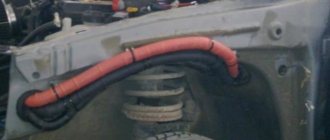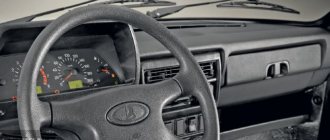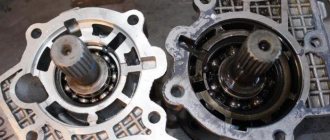It is indispensable if you live outside the city, it justifies itself as a car for the whole family and is very stable. With the arrival of the autumn-winter period, good and high-quality operation of the heater will be relevant. If the stove does not heat well, the Chevrolet Niva will become a very uncomfortable car, and you will have to forget about its advantages. Moreover, if the car was parked in the garage overnight, it is problematic to be in it and feel the cold comparable to that of a basement. Let's consider the main components of this technological unit of the car:
- radiator;
- fan;
- dampers;
- pipes;
- air duct;
- unit for regulating fluid movement.
The stove will work properly if each of its parts works properly and in a coordinated manner.
Main malfunctions and methods for eliminating them in the Chevrolet Niva car stove:
- The ventilating elements of the heater burned out. This will be immediately visible in winter by the formation of characteristic condensation on the windows. They simply need to be replaced with new ones;
- the unit that regulates the temperature breaks, since it can be made of plastic rather than rubber or rubber, which has greater wear resistance. Naturally, the possibility of the cable falling off should also be considered. Depending on the situation, you either carefully return the part to its place and it continues to perform its traction function, or you need to purchase a new one and replace it;
- poor filter performance due to clogging. Accordingly, they need to be cleaned or purged, otherwise air pockets will form in the stove, disrupting its productive operation;
- problems with the cooling system - you should rinse and fill in a new coolant - antifreeze or antifreeze, which is changed annually for prevention;
- The damper that regulates the supply of cold and hot air has broken. It will have to be replaced;
- The thermostat is not working well. It might simply get jammed. Please note that the heater will malfunction when driving fast. It must be replaced immediately, because poor quality work will lead to an increase in temperature throughout the Chevrolet Niva;
- The resistor on the radiator has burned out or the radiator is clogged. There can be many reasons: antifreeze, insects, leaves and other debris. Also, water should not be allowed to get into this part of the stove. The radiator must be cleaned periodically, and in case of a malfunction, a new resistor must be purchased and installed. Cleaning is carried out with compressed air or a vacuum cleaner, an industrial hair dryer;
- The heater control unit, the so-called controller responsible for regulating the interior temperature, may fail. This is already a problem with electronics; to fix it, you need the services of a specialist.
Recommendations for normal and long-term operation of the heating-cooling system in a Chevrolet Niva:
- periodically lubricate the bearings of the stove ventilation device;
- Check the filters and radiator regularly, and if necessary, clean them or purchase new ones. The filter cleans the air from dust and infections coming from the street;
- remove air pockets when the engine is idling and muffled;
- clean the pipes with citric acid or a special product, since poor quality coolant forms sediment and build-up in the pipes.
At a temperature of minus 20 degrees, the Chevrolet heating system should heat the top of the cabin to an average of 10 degrees, and the temperature in the legs is 5-7 degrees higher. Passengers in the rear seats will receive air with a temperature of about 14 degrees. This way, everyone will be in comfortable conditions, and the trip in winter will be quite pleasant.
To avoid problems with the heating and ventilation system, preventive maintenance should be carried out systematically. After all, a car is a complex device that will drive well and function properly only with proper care.
Of course, problems with the stove are not the most critical troubles or breakdowns, but your health, mood and, naturally, performance depend on your comfort and the comfort of your passengers. We value not the quantity, but the quality of the years lived, so let your Chevrolet Niva be a high-quality, elegant and capable car.
How to fix the problem in which the stove on a Chevrolet Niva does not blow at your feet
It is not difficult to fall in love with a vehicle like the Chevrolet Niva with all your heart. The car is truly beautiful and comes with a fair amount of benefits. Unfortunately, in modern reality it is almost impossible to find a device or mechanism that does not have flaws.
The Chevrolet Niva was also no exception, so it is not at all surprising that after some period of direct operation of this vehicle, complaints from car owners begin to arrive. This flow of some discontent especially intensifies in the winter.
Complaints are related to the fact that on the Chevrolet Niva the stove does not blow into the feet at all, which freeze very quickly, depriving both the driver and passengers of comfort. Why the stove refuses to blow in this direction is not a mystery. It’s just that most drivers are convinced that this is a technical defect due to insufficient attention from the designers who developed such a model.
To ensure proper comfort for the driver and passengers, it will be necessary to modify the heater damper drive.
This way you can come to an agreement with the Niva Chevrolet stove and make it evenly warm up the interior.
The stove is good (if it works). The stove is hot, the cabin is warm, I can’t find where to blow into my feet...
The filter cleans the air from dust and infections coming from the street; remove air pockets when the engine is idling and muffled; clean the pipes with citric acid or a special product, since poor quality coolant forms sediment and build-up in the pipes. As a result, it cannot effectively blow in several directions at once, but when the flow is directed towards the legs, the air is distributed anywhere, but not in the desired direction. This is done as follows:
If you move the lever in the opposite left direction until it stops, air will flow between the side and top deflectors. Actually, this is a design feature of this model.
Unfortunately, in modern reality it is almost impossible to find a device or mechanism that does not have flaws. The Chevrolet Niva was also no exception, so it is not at all surprising that after some period of direct operation of this vehicle, complaints from car owners begin to arrive. This flow of some discontent especially intensifies in the winter.
Complaints are related to the fact that on the Chevrolet Niva the heater does not blow into the feet at all, which freeze very quickly, depriving both the driver and passengers of comfort.
Why the stove refuses to blow in this direction is not a mystery. It’s just that most drivers are convinced that this is a technical defect due to insufficient attention from the designers who developed such a model.
The radiator must be cleaned periodically, and in case of a malfunction, a new resistor must be purchased and installed. Cleaning is carried out with compressed air or a vacuum cleaner, an industrial hair dryer; The heater control unit, the so-called controller responsible for regulating the interior temperature, may fail.
We recommend: Why antifreeze boils in the expansion tank: a review of common breakdowns
This is already a problem with electronics; to fix it, you need the services of a specialist. Recommendations for normal and long-term operation of the heating-cooling system in a Chevrolet Niva: The filter cleans the air of dust and infections coming from the street; remove air pockets when the engine is idling and muffled; clean the pipes with citric acid or a special product, since poor quality coolant forms sediment and build-up in the pipes.
At a temperature of minus 20 degrees, the Chevrolet heating system should heat the top of the cabin to an average of 10 degrees, and the temperature in the legs is degrees higher.
You can also relatively smoothly regulate the amount of air supplied in different directions. After such a modification, you may encounter a decrease in air flow. This is due to air redistribution.
Chevrolet Niva 2004, 80 l. With. — self-repair
The result is that in the middle position the cabin is still quite cool. To eliminate this drawback, you will need an unnecessary plastic canister.
We cut off the neck from it and attach it to the deflector. The result is a fairly powerful and targeted flow.
The cause of cold in the cabin may also be a simple heater failure. Therefore, we will consider the most common causes of breakdowns. All of them lie on the surface, and in principle are characteristic of many modern cars. The most common cause is a blown fuse. Check the appropriate fuse and replace it if necessary.
The main reasons when the stove does not blow warm air into your feet
The heater radiator is leaking
Before gutting the air ducts and air dampers, you need to make sure that the antifreeze warms up to its operating temperature.
And this may depend on a lot of factors - the quality of the pump , the tightness of the system and the heater radiator , including the correct operation of the thermostat, and the quality of the coolant. If the temperature with a fully warmed-up engine is within 80-90 degrees, we look for the reasons for the lack of air in the legs in the design of the heater.
Turn on maximum heat.
A feature of the stove on a Chevrolet Niva is the absence of a heater radiator tap, that is, antifreeze circulates in a full circle in winter and summer and passes through the heater radiator. Taking this fact into account, the factory somewhat complicated the design of the air ducts and air dampers - there are two of them in the Chevrolet Niva.
Upper deflector flap.
One works for frontal airflow, the second is responsible for supplying air to the feet of the front and rear passengers and the driver. It is with this damper that problems arise that we will try to solve.
Correctly turn on the foot airflow
It turns out that even after several years of owning a Niva Chevrolet, not everyone knows how to properly turn on the warm air to blow their feet. By using fan speed controls and damper position controls, and using sound logic, we can end up with a situation where the entire flow of hot air is directed onto the windshield and into the face of the driver and front passenger. Of course, the car is warm, even hot, but your feet are cold.
Practice has shown that Shniva has a special algorithm for supplying hot air to the legs . On most instances this is done like this:
- We warm up the engine until the flow of warm air is clearly felt by the hand.
- The fan speed switch is set to the fourth position, 4th speed.
- Turn the airflow direction knob to exactly 12 o'clock.
- Immediately return it to the 10-11 o'clock position.
Correct position of the stove blower control.
- The air damper will make a characteristic click and the air flow will flow to your feet. Now you can set the blowing intensity at your discretion.
- If this method did not work the first time, the second or third time it works in 90% of cases.
Having remembered this sequence, you will have to turn on the airflow several times, after which the damper will rub in and find the desired position itself in accordance with the pictogram on the adjustment handle.
It's all about the inaccuracy of assembling the heater assembly - backlashes and gaps interfere with air distribution and setting the damper in the desired position from the first turn on.
Chevrolet Club - Information
First of all, check the flow in the expansion tank at idle. There should be a vigorous flow. If there is no stream, then throw the pump in the trash. The pump must be original, no cheap one will do, it has a smaller impeller. With a non-original or faulty pump, a stream appears in the tank only when you re-gas it.
Pump and test. Lech wrote:. Good day everyone! I would also like to make my small contribution to the forum if, of course, anyone else is interested. Not long ago I had problems with the heater which I solved by replacing the pump. If I posted the topic incorrectly, please correct me.
The essence of my problem was that with the engine well warmed up, the temperature in the cabin left much to be desired. The strong air flow from the heater was lukewarm. Thanks to the respected forum participants, the decision was made to change the pump. Indeed, in my case, the stream in the reservoir at idle was completely absent, appearing only closer to the engine speed. Having removed the pump, it turned out that there was a “hepa” with a small impeller:. The hepa impeller has a diameter of 64mm. The TZA impeller has a diameter of 72mm.
Measuring the air temperature from the heater in the glass mode with a well-warmed engine before replacing the pump showed the following result: After replacing the pump with the original one, a steady stream appeared in the expansion tank at idle speed and the heater air temperature in the same mode on the glass increased significantly: Now I I felt warm, I even unscrew the heat-cold knob to 12 hours, otherwise it’s too hot..
The presence of a wheel on the windshield is especially incomprehensible. What can we now understand from this diagram? Theoretically, nothing blows from there until you put the front in position.
In practice, it constantly blows from the front if the dampers are not treated using the technology below. In short, you need to turn the wheel in the front position. Feel what is blowing from there and never touch it again. Additional airflow to the windshield never hurts. The diagram has errors, but not major ones, the main thing is to grasp the meaning. Treatment using technology improves the overall warming of the feet.
Indications for treatment are:. This bonus significantly increases the comfort in the car interior when the damper is in frosty weather.. Bigfoot wrote a:. Everything works perfectly, now it blows where I want, in the legs of Tashkent it even blows in the legs of the rear passengers. This has never happened before.. It is better to increase the efficiency of heating the legs by eliminating air leaks from the large technological holes podiums for fastening the damper cables, which are installed at the factory no one is fooling around.
The holes are through, air is blown out of them from the stove... Here they are visible in the light. Don’t put the foam rubber too far into them, otherwise the damper will jam the heat and cold. In the photo the largest one is in the center. The flap with its small squiggle on the right can pinch and drag pieces of foam rubber inside. Where else can cold air siphon from?
From the joints of part number 4. Owners of Shniv with a condo can relax or tense up. Because simply removing the glove compartment will not solve anything. But you can check it by removing the glove compartment and rushing through in the cold with a breeze, the passenger can feel everything.. No problems were found with the other joints. Maybe this will reassure owners of Eltse trim levels.
see also
Comments 29
Good afternoon
